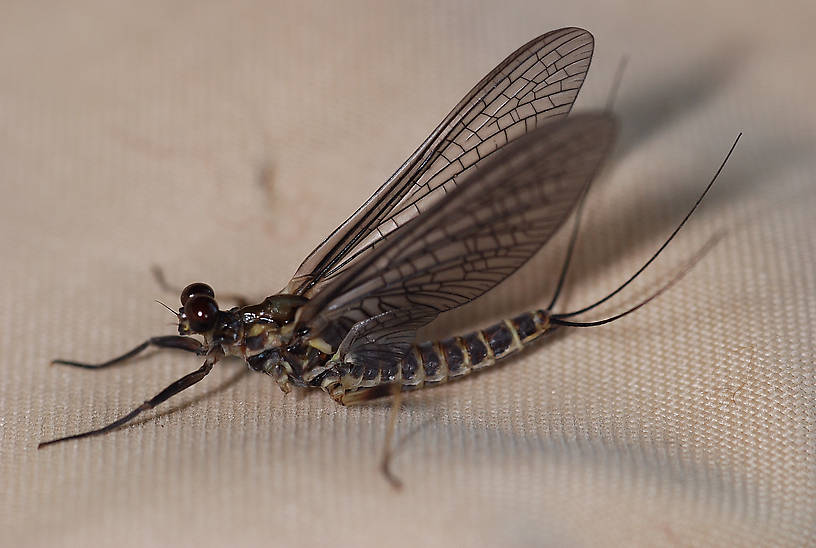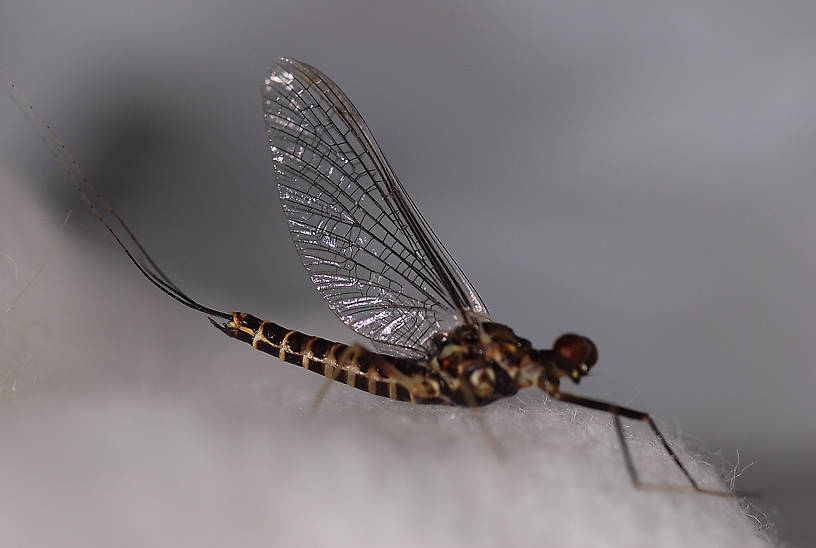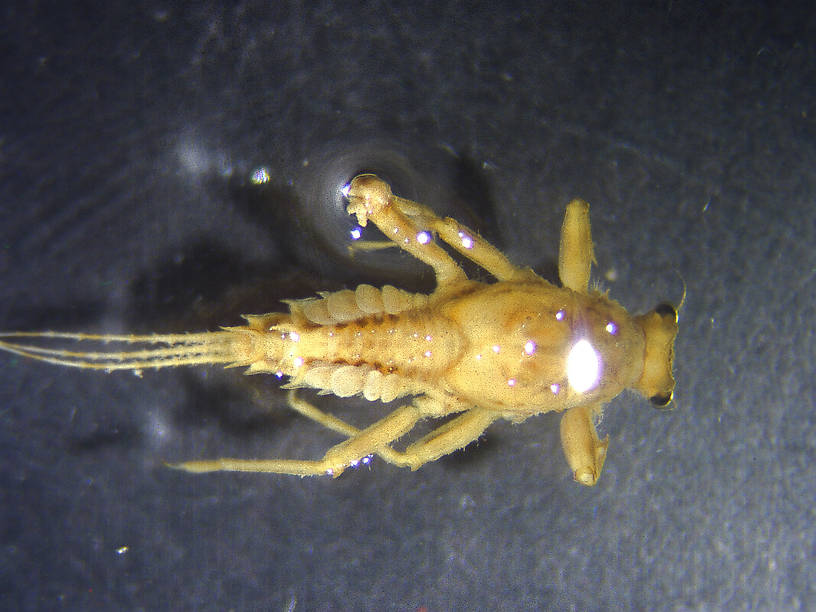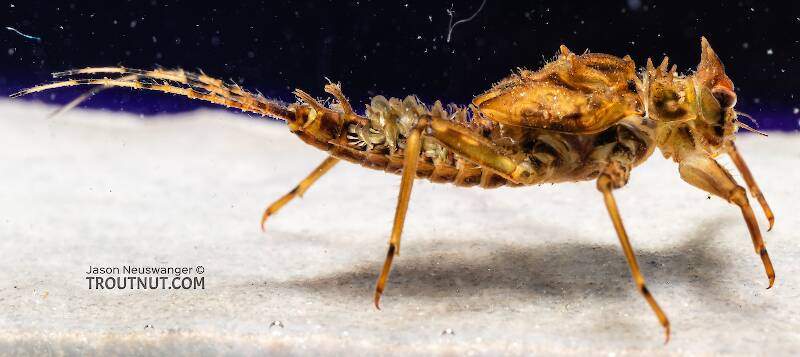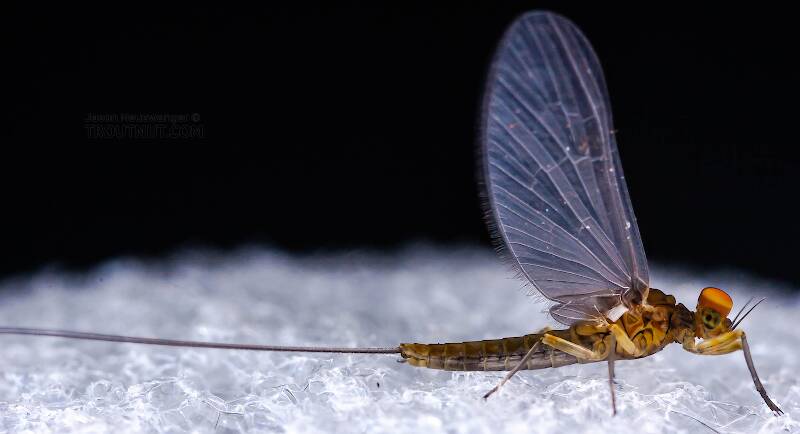
Blue-winged Olives
Baetis
Tiny Baetis mayflies are perhaps the most commonly encountered and imitated by anglers on all American trout streams due to their great abundance, widespread distribution, and trout-friendly emergence habits.
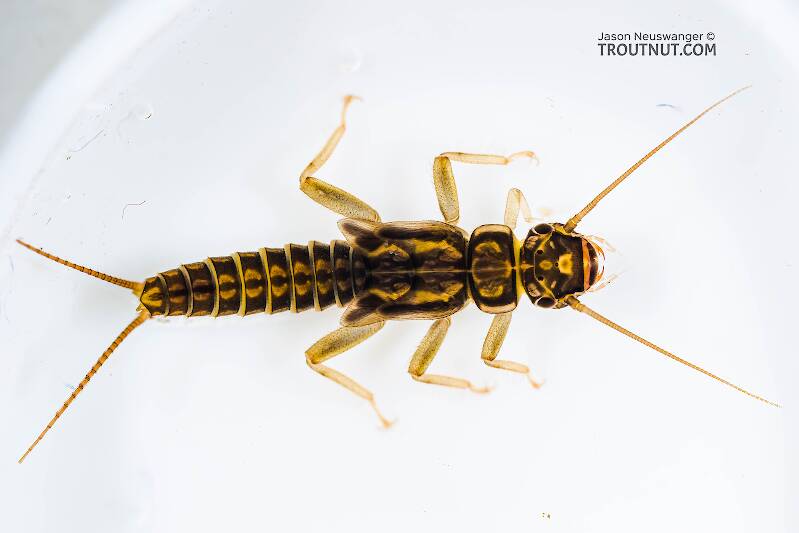
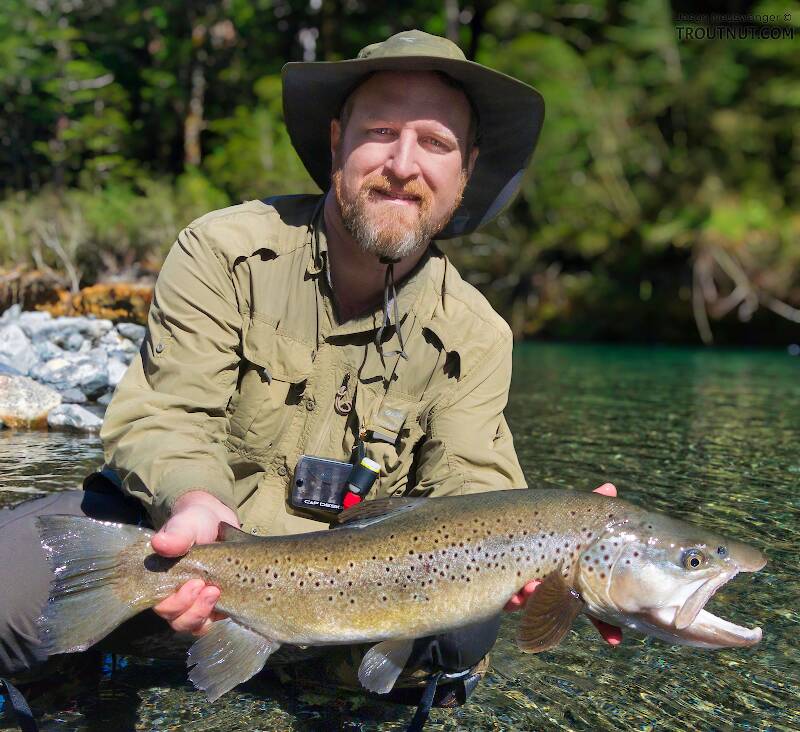
Mayfly Species Drunella spinifera (Western Slate Olive Duns)
Where & when
This species is most prevalent near the Pacific Coast, but scattered local populations occur throughout the northern states of the West.In 1 records from GBIF, adults of this species have been collected during November (100%).
In 2 records from GBIF, this species has been collected at elevations of 1982 and 3300 ft.
Species Range
Spinner behavior
Time of day: Dusk
Identification
To determine whether a specimen of Drunella belongs to Drunella spinifera, use the Key to Species of Drunella Nymphs.
Physical description
Most physical descriptions on Troutnut are direct or slightly edited quotes from the original scientific sources describing or updating the species, although there may be errors in copying them to this website. Such descriptions aren't always definitive, because species often turn out to be more variable than the original describers observed. In some cases, only a single specimen was described! However, they are useful starting points.
Male Nymph
Color light brown, but this is probably due to fading in the alcohol and fresh specimens may be considerably darker and show an abdominal pattern. Head with a pair of long, erect, pointed tubercles on vertex, about as long as distance separating them. Pronotum with a twin pair of tubercles on each side subdorsally, situated on posterior half of segment, the anterior one being twice as high as the posterior one, both pointed; a lateral pointed tubercle at same level as anterior subdorsal one and somewhat smaller than this.
Mesonotum with a small pair of rounded wart-like tubercles, situated subdorsally on anterior margin; laterad and slightly posterior to these on each side is a longer, sharply pointed tubercle, directed slightly backwards; in central area is a pair of long, pointed subdorsal tubercles, twice as large as the preceding pair, and also slightly slanting backwards, and there is a single median rounded wart-like prominence on the posterior portion, equivalent to the scutellum of the adult; in the latero-anterior angle is a small rounded wart, separated by a slight excision from a still smaller wart, placed directly behind it; somewhat dorsad of these is a slight raised ridge.
On abdomen dorsally segments 2-7 bear each a pair of sharply pointed, spine-like tubercles on the posterior margin; these are all practically equal in length and directed slightly backward; the two on segment II are closer together than those on the following segments and on segments 1V-VII the distance between the tubercles is slightly greater than their height. On segments VIII and IX the spine-like tubercles are enormously increased in size and fully four times the length of the preceding pairs; they are pointed and covered with long, scattered bristles, the pair on VIII faintly divergent apically, those on IX slightly smaller than on VIII, subparallel and rather more decumbent. Tails light brown in basal fourth, broadly ringed with darker brown in outer three-quarters. Lateral spine-like prolongations of abdominal segments III-VII increasing in size from front to rear; lateral margin of VII slightly convex, of VIII and IX distinctly sinuate, the prolongations on these last two segments being subequal and somewhat longer than on VII. Ventrally on abdomen are sub-lateral rows of dark brown dashes, one dash to each segment. Legs pale brown, the femora of two posterior pairs showing traces of two dark transverse bands on outer sides; hind tibia equal in length to femur and trochanter combined.
Male Spinner
Wing length: 15 mm
A species of the fuscata (now a synonym of Drunella walkeri) group, allied to E. spinifera (now a synonym of Drunella spinifera).
Eyes deep reddish brown. Head black; pits at bases of antennae "and a small area posterior to mid-ocellus pale yellowish. Pronotum black with yellowish shades laterally” (McD.) at bases of fore legs. Mesonotum black; pale yellowish brown markings as indicated; a “lateral streak extending forward from base of wing, the lateral edge of the anterior projection, the lateral posterior edges reaching caudad to beginning of scutellum and relieving in this region a black dorsal band as broad as and extending over scutellum” (McD.). Metathorax black; slight yellowish shading on scutellum, intersegmental areas of pleura and around bases of legs. Fore femur and tibiae light amber, “heavily suffused with blackish, the pale color only showing at bases of femora and at joint” (McD.); tibia subequal to femur; tarsus light smoky amber. Middle and hind femora and tibia light amber, the femora suffused with blackish in distal third; tibia as long as femur and trochanter together; tarsi and claws dull smoky. Wings hyaline, tinged faintly with smoky in stigmatic area. Veins and cross veins rather fine, dark; stigmatic cross veins paler.
Abdominal tergites 1 and 2 almost wholly black; 3-7 blackish, anterior margins narrowly pale smoky, these are broader at median area of tergite 7. Traces “of a geminate dark median line filled with pale color; on segments 5-7 there is a tendency for the black area to break up into three patches, due to paler submedian prongs projecting from the posterior pale area into and almost separating the dark area; Iaterally there are faintly pale comma-shaped marks in the dark areas” (McD.). Tergites 8 and 9 all black except a narrow pale posterior margin; 10 pale, "narrowly dark on anterior border with median and lateral prongs projecting backward into the pale area” (McD.). Sternites 2-7 with a narrow pale anterior margin and wider pale posterior margin, blackish between these pale bands; two pale submedian lunate marks on anterior margin, two small dots near center of segment, and a larger lateral pale dot or dash, on dark portion of each sternite. Sternites 8 and 9 black; posterior margin of 9 pale. Forceps blackish; yellowish brown apically; base pale yellowish brown. Tails black.
Nymph
Nymph quite similar to E. spinifera (now a synonym of Drunella spinifera), but differing in these points: twin spines on pronotum subequal; postero-lateral spines of segments 8 and 9 shorter, most evident of 9; long dorsal abdominal spines on segment 8 “more strongly bent backward and downward” (McD.). The species matures fully a month later than spinifera.
Specimens of the Mayfly Species Drunella spinifera
1 Female Dun
1 Male Spinner
2 Nymphs
Start a Discussion of Drunella spinifera
References
- Arbona, Fred Jr. 1989. Mayflies, the Angler, and the Trout. Nick Lyons Books.
- Knopp, Malcolm and Robert Cormier. 1997. Mayflies: An Angler's Study of Trout Water Ephemeroptera . The Lyons Press.
- McDunnough, J. 1934. New species of North American Ephemeroptera IV. Canadian Entomologist 66: 154-164.
- Needham, James G., Jay R. Traver, and Yin-Chi Hsu. 1935. The Biology of Mayflies. Comstock Publishing Company, Inc.
Mayfly Species Drunella spinifera (Western Slate Olive Duns)
Species Range
Common Names
Resources
- NatureServe
- Integrated Taxonomic Information System
- Global Biodiversity Information Facility
- Described by Needham (1927)


